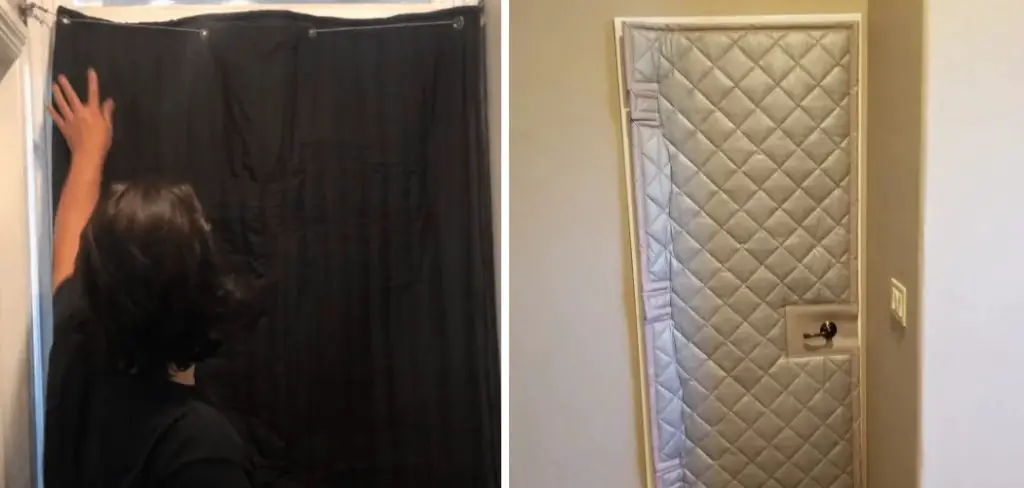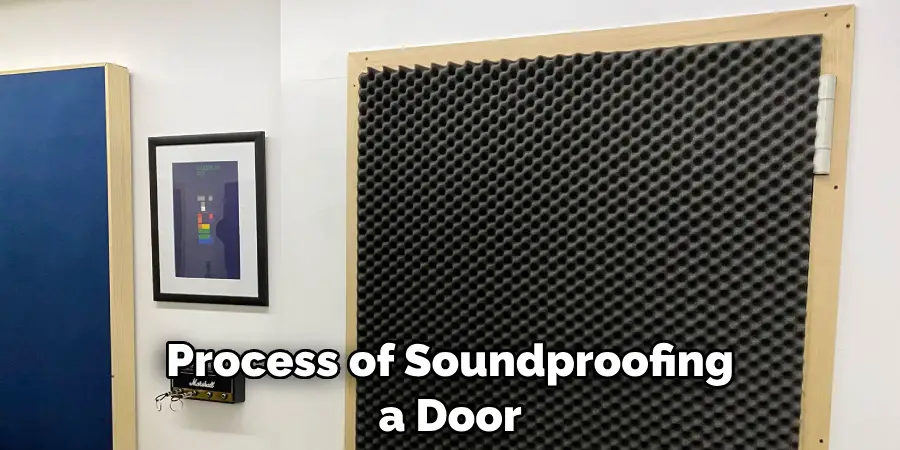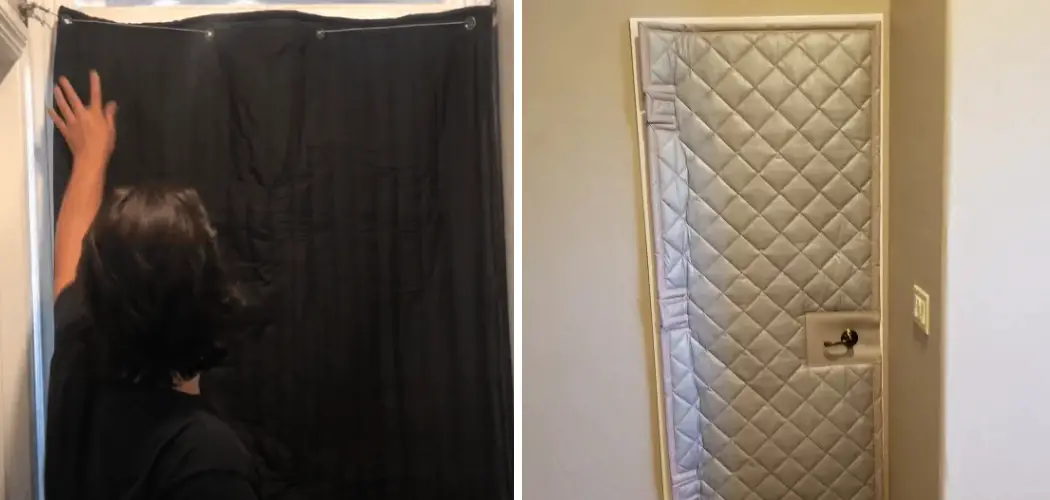If you live in a noisy apartment building or an area with frequent loud noises, then soundproofing your door can be the difference between peace and chaos. Using household items to soundproof your door can drastically reduce noise transmission and improve overall sound quality in your home. This DIY project is relatively simple and cost-effective, but it may take a few days to soundproof your door properly.

One of the major advantages of using household items to soundproof a door is that it is a cost-effective solution. It eliminates the need for expensive acoustic materials and reduces labor costs for installation.
This method also results in improved noise reduction, as you can create layers of insulation with multiple household items to absorb more sound than just one layer of material. In this blog article, you can find step-by-step instructions on how to soundproof a door with household items.
Step-by-Step Processes for How to Soundproof a Door With Household Items
Step 1: Inspect the Door and Frame
Before beginning the soundproofing process, inspect the door and frame for gaps, holes, or other areas that may let in sound. These can include around the hinges, at the corners of the door and frame, and any other places where two surfaces meet up.
Step 2: Pre-Treat Door Frame
Once the inspection is complete, it’s time to begin pre-treating the door frame. This can be done using a combination of caulk and putty that can be found at most hardware stores. Caulk should be applied around any gaps, while putty should be used to fill any holes or cracks in the frame. This will help prevent sound from escaping further.

Step 3: Place Furniture in Front of the Door
Using furniture is one of the easiest options when it comes to soundproofing a door with household items. Placing heavy pieces such as dressers, bookshelves, and couches in front of the door can significantly reduce any sound that’s coming through. This is especially useful for rooms where noise, such as a bedroom or office, can easily travel in and out of the space.
Step 4: Hang Blankets or Curtains
Another option when it comes to soundproofing a door with household items is to hang blankets or curtains along the door frame. It serves the dual purpose of making the room look more aesthetically pleasing while also dampening any sound that may be trying to pass through. Simply hang the blankets or curtains as close to the door and frame as possible, ensuring they are secure and won’t easily fall down.
Step 5: Install Weather Stripping
Installing weather stripping is the final step in soundproofing a door with household items. This helps to create an additional barrier between the frame and door, preventing sound from passing through any tiny gaps or cracks. Simply measure the length of the door frame and cut the weather stripping accordingly. Attach it along the inside portion of the frame for the most effective results.

By following these steps, anyone can easily soundproof their door using only household items. This is a great option for those who need a quick and easy solution without spending too much money on expensive materials or tools.
Tips for How to Soundproof a Door With Household Items
- Always wear gloves and safety goggles to protect your eyes from exposure when using adhesives.
- Ensure the doors are clean before applying any soundproofing material or adhesive. Dirt, dust, or other debris may affect the materials’ effectiveness.
- Be aware of the fire safety rating of soundproofing materials before applying them. Some materials, like foam rubber, may be flammable and should not be used near heat sources or open flame.
- Exercise caution when drilling holes into the door frames to insert soundproofing material, as they could weaken the structure of the door. Be sure to use the appropriate drill bit for the material of your door.
- When using sealants or caulking, always wear a face mask and gloves to protect yourself from inhaling any fumes or getting the product on your skin.
- Always read and follow the manufacturer’s instructions when using any type of soundproofing material.
- If you are unsure of what type of soundproofing materials or adhesives to use, consult a professional such as an acoustic engineer or contractor familiar with noise control and soundproofing.
You can ensure a successful and safe project by following these tips and taking the necessary safety precautions when attempting to soundproof a door with household items.

What Are the Best Household Items for Soundproofing a Door?
When it comes to soundproofing a door with household items, there are many materials that can be used. Some of the most effective materials include weather stripping, foam insulation, mass-loaded vinyl, rugs, and carpets, blankets, and curtains. Weatherstripping is an easy and affordable way to reduce noise coming through a door. It helps to seal any gaps around the door and provides a barrier between the outside and inside of your home.
Foam insulation is another material that can be used to soundproof a door. This material can be cut into strips, which are then placed between the door frame and the wall. It’s important to make sure that the insulation is sealed tightly to ensure maximum soundproofing. Mass-loaded vinyl can also be used for soundproofing a door. This material helps to absorb sound and noise levels. It’s inexpensive and can be installed on the sides of the door for maximum protection.
Are There Any Risks Associated With Using Household Items to Soundproof a Door?
In general, there are not usually any risks associated with using household items to soundproof a door. However, it should be noted that some of the materials used may contain toxic chemicals or fumes that can cause allergic reactions or other health problems. Additionally, if the material is applied incorrectly,, it could result in air leakage or create an imbalance in the room.
Therefore, taking extra precautions when using household items to soundproof a door is important. It is also essential to ensure that proper ventilation and safety measures are followed during the process. Furthermore, if possible, it is best to consult with a professional in order to get an accurate assessment of the risks associated with using household items to soundproof a door.

Is Soundproofing a Door With Household Items Effective?
Soundproofing a door with household items effectively reduces noise levels entering or exiting your home. Common materials such as weatherstripping and egg cartons can be used to block out sound. Heavier materials such as carpets, rugs, and blankets will be needed for more soundproofing needs.
When choosing which materials to use for soundproofing, consider the level of noise reduction desired. Some materials will be more effective than others based on their density and how well they block out sound waves.
For smaller gaps in a door, weatherstripping is often the best choice. This can be found at most home improvement stores and is easy to install. Weatherstripping is made of rubber or foam, and it is used to fill any gaps that allow sound to pass through. It also acts as an air sealant and helps keep drafts out of your home.
How Long Does the Process of Soundproofing a Door With Items Typically Take?
The process of soundproofing a door with household items typically takes around an hour to complete. The amount of time it will take depends on the type and number of materials you use. You’ll need to measure the door, cut your insulation pieces, and then attach them with adhesive or tape. This process can be sped up by using pre-cut pieces of insulation and tape, but the soundproofing effect may not be as effective.

After attaching the materials to the door, you’ll likely need to seal any gaps around the edges with caulk or weatherstripping for extra soundproofing. This part of the process will add a few additional minutes to your total time, depending on the size of the gaps.
Overall, soundproofing a door with household items is an easy and relatively fast task that can be done in under an hour. With some basic knowledge and supplies, you can significantly reduce the amount of sound coming into your home or room without purchasing expensive materials or hiring a professional. It’s important to take your time and be thorough when attaching the insulation pieces and sealing the gaps for optimal soundproofing.
What Are the Benefits of Using Household Items for Soundproofing a Door?
Using household items to soundproof a door is a great way to reduce noise from entering or exiting the room. It can really help you create a more peaceful and quiet environment in your home. The materials used for this job are usually relatively inexpensive, so it’s an affordable option for the budget-conscious homeowner.
Additionally, you don’t need any special tools or skills to do the work, so it can be done quickly and easily. One of the main benefits of using household items for soundproofing a door is that you don’t need to purchase expensive materials from a store.
Instead, you can use things like old blankets, towels, thick rubber mats, and foam sheets to cover the door. You can also use a weather-stripping sealant around the edge of the door for added soundproofing power.
Another great benefit of using household items for soundproofing a door is that it’s an easy and relatively low-cost way to reduce noise levels in your home. Depending on the materials you use, you can create a soundproofing barrier that is effective and long-lasting without spending a lot of money.
Conclusion
The main disadvantage of soundproofing a door with household items is that it usually doesn’t provide complete soundproofing. Household items generally don’t have the same level of noise-canceling capabilities that professional materials do, so some sound may still be able to get through the door even after soundproofing.
In conclusion, soundproofing a door with household items is an effective and relatively easy task. By utilizing common materials such as blankets, rugs, foam, weatherstripping, and caulking, you can reduce the amount of noise that passes through your door.
Furthermore, adding mass to the door can further increase sound reduction. Be sure to take all necessary safety precautions and use the appropriate materials for your door type. I hope reading this post has helped you learn how to soundproof a door with household items. Make sure the safety precautions are carried out in the order listed.

